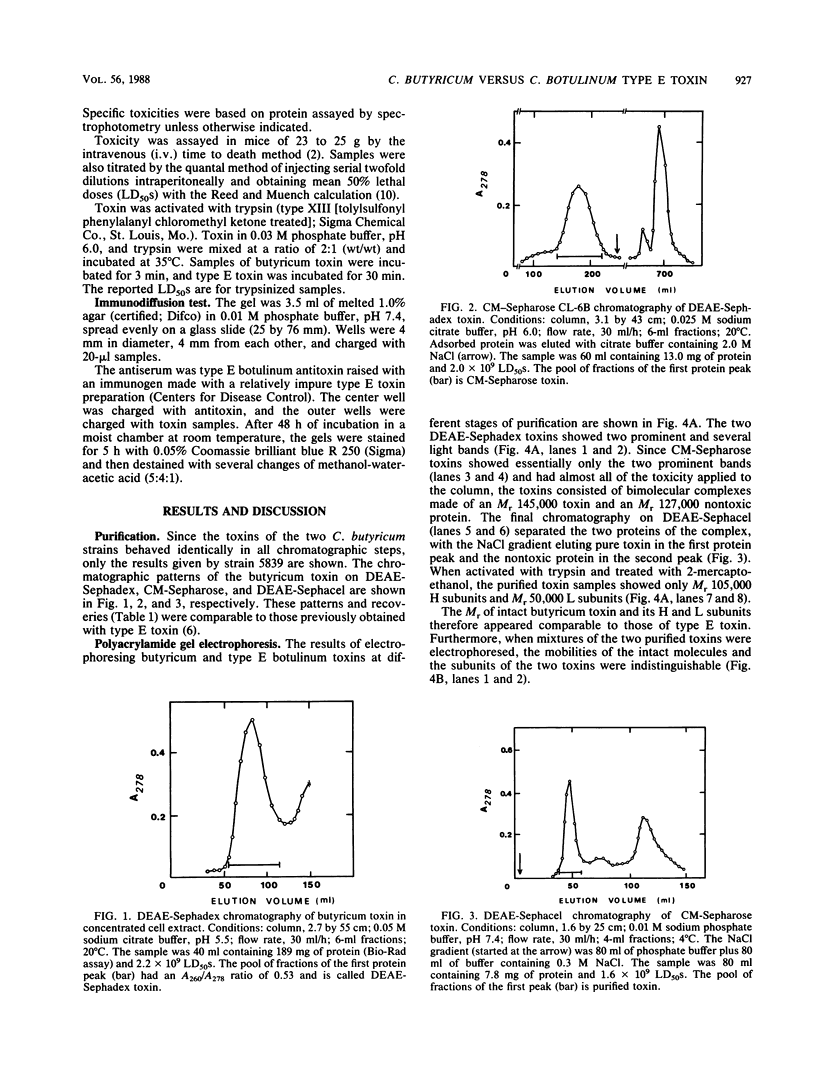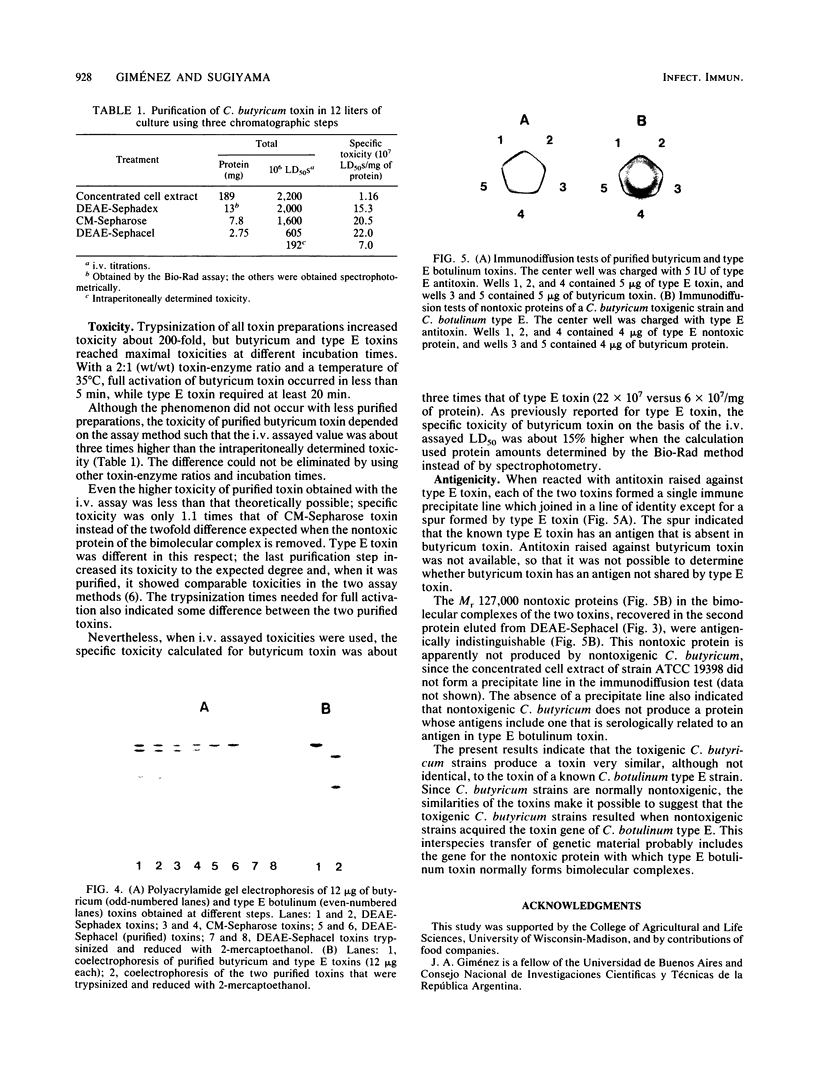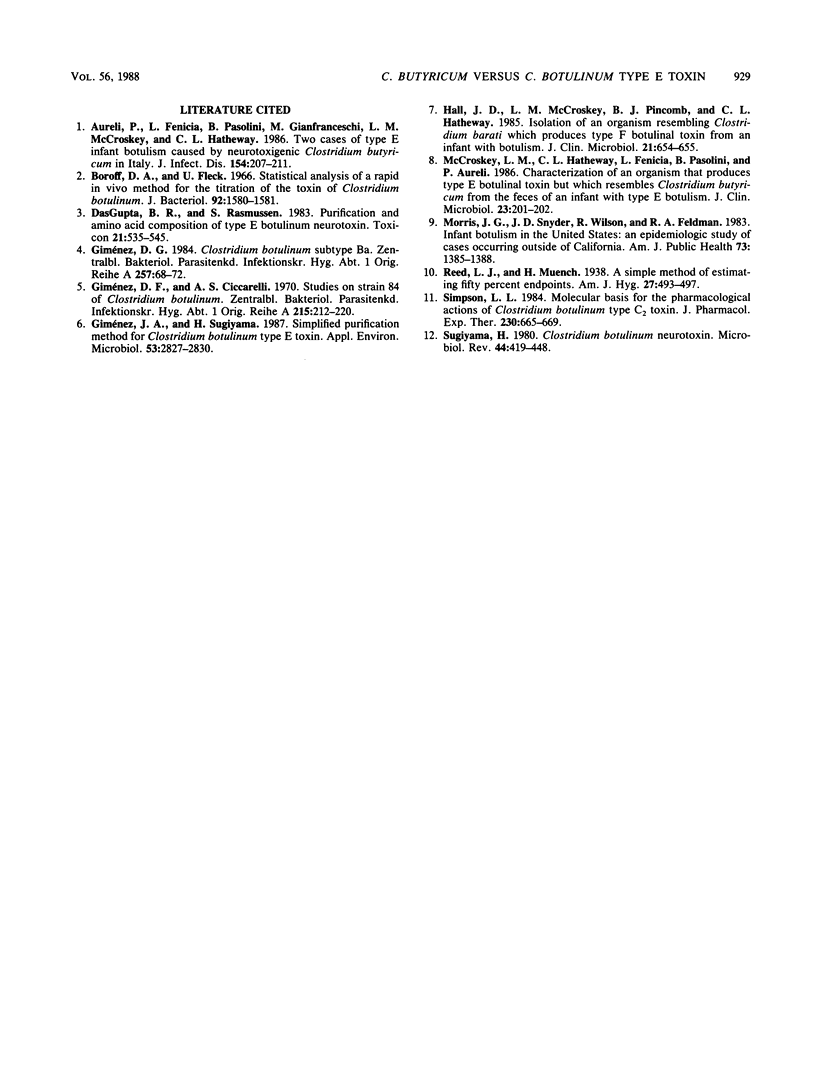Abstract
The toxin of Clostridium butyricum strains isolated from two infants with botulism is neutralized by antitoxin for type E botulinum toxin. This toxin and that of a C. botulinum type E strain were purified by the same protocol. Both toxins were Mr 145,000 proteins which, when activated with trypsin, were composed of an H subunit of Mr 105,000 and an L subunit of Mr 50,000. The activated specific toxicity of purified butyricum toxin based on an intravenous assay was 2 X 10(8) mouse 50% lethal doses (LD50s)/mg of protein, but that based on an intraperitoneal assay was 7 X 10(7) LD50s/mg, compared with 6 X 10(7) LD50s/mg for type E toxin as determined by both methods. Immunodiffusion tests with antitoxin raised with type E toxin indicated that the two toxins were serologically very similar except for a spur formed by type E toxin. The close similarities of the two toxins suggest that toxigenic C. butyricum could arise when a wild-type strain, which is normally nontoxigenic, acquires the toxin gene of a C. botulinum type E strain.
Full text
PDF



Images in this article
Selected References
These references are in PubMed. This may not be the complete list of references from this article.
- Aureli P., Fenicia L., Pasolini B., Gianfranceschi M., McCroskey L. M., Hatheway C. L. Two cases of type E infant botulism caused by neurotoxigenic Clostridium butyricum in Italy. J Infect Dis. 1986 Aug;154(2):207–211. doi: 10.1093/infdis/154.2.207. [DOI] [PubMed] [Google Scholar]
- Boroff D. A., Fleck U. Statistical analysis of a rapid in vivo method for the titration of the toxin of Clostridium botulinum. J Bacteriol. 1966 Nov;92(5):1580–1581. doi: 10.1128/jb.92.5.1580-1581.1966. [DOI] [PMC free article] [PubMed] [Google Scholar]
- DasGupta B. R., Rasmussen S. Purification and amino acid composition of type E botulinum neurotoxin. Toxicon. 1983;21(4):535–545. doi: 10.1016/0041-0101(83)90131-9. [DOI] [PubMed] [Google Scholar]
- Giménez D. F., Ciccarelli A. S. Studies on strain 84 of Clostridium botulinum. Zentralbl Bakteriol Orig. 1970;215(2):212–220. [PubMed] [Google Scholar]
- Giménez J. A., Sugiyama H. Simplified purification method for Clostridium botulinum type E toxin. Appl Environ Microbiol. 1987 Dec;53(12):2827–2830. doi: 10.1128/aem.53.12.2827-2830.1987. [DOI] [PMC free article] [PubMed] [Google Scholar]
- Hall J. D., McCroskey L. M., Pincomb B. J., Hatheway C. L. Isolation of an organism resembling Clostridium barati which produces type F botulinal toxin from an infant with botulism. J Clin Microbiol. 1985 Apr;21(4):654–655. doi: 10.1128/jcm.21.4.654-655.1985. [DOI] [PMC free article] [PubMed] [Google Scholar]
- McCroskey L. M., Hatheway C. L., Fenicia L., Pasolini B., Aureli P. Characterization of an organism that produces type E botulinal toxin but which resembles Clostridium butyricum from the feces of an infant with type E botulism. J Clin Microbiol. 1986 Jan;23(1):201–202. doi: 10.1128/jcm.23.1.201-202.1986. [DOI] [PMC free article] [PubMed] [Google Scholar]
- Morris J. G., Jr, Snyder J. D., Wilson R., Feldman R. A. Infant botulism in the United States: an epidemiologic study of cases occurring outside of California. Am J Public Health. 1983 Dec;73(12):1385–1388. doi: 10.2105/ajph.73.12.1385. [DOI] [PMC free article] [PubMed] [Google Scholar]
- Simpson L. L. Molecular basis for the pharmacological actions of Clostridium botulinum type C2 toxin. J Pharmacol Exp Ther. 1984 Sep;230(3):665–669. [PubMed] [Google Scholar]
- Sugiyama H. Clostridium botulinum neurotoxin. Microbiol Rev. 1980 Sep;44(3):419–448. doi: 10.1128/mr.44.3.419-448.1980. [DOI] [PMC free article] [PubMed] [Google Scholar]




